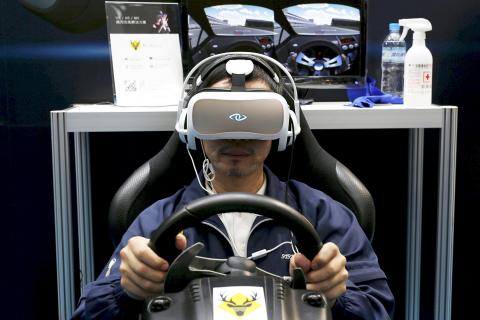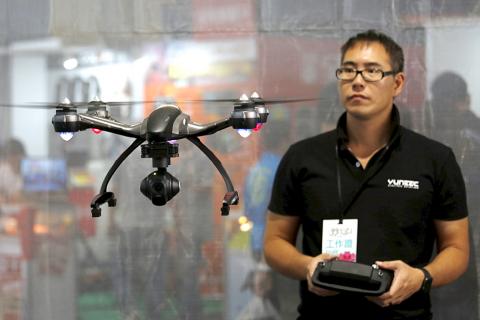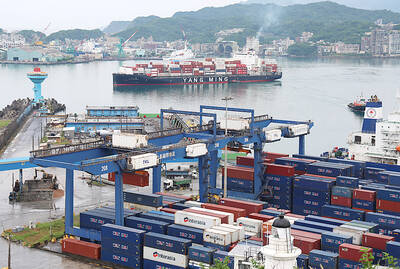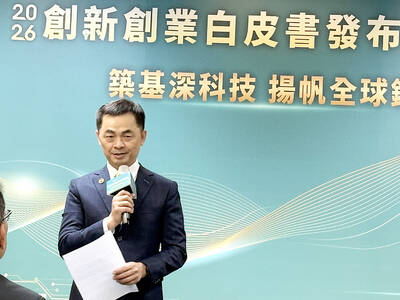The development of the virtual reality (VR) industry is still in its early stages, but the potential global market could reach US$13.5 billion by 2020 from this year’s US$2.54 billion, JPMorgan Securities Ltd said.
Apart from the anticipated fourfold increase in the overall market, gaming and entertainment applications are likely to take off faster than other VR applications, the brokerage said in a report.
“We think VR is promising and that it innovates the ways humans interact with machines,” JPMorgan analysts led by Narci Chang (張恆) said in the report issued on Thursday.

Photo: Tyrone Siu, Reuters
At the Taipei Spring Computer Show (Softex Taipei), which opened on Thursday and runs until Monday at the Taipei World Trade Center’s Exhibition Hall 1, VR products have drawn the most attention.
Swarms of VR fans lined up at a booth where they could experience a virtual roller-coaster ride by wearing a VR headset and sitting in a specially designed chair.
JPMorgan analysts forecast that the VR industry could register a compound annual growth rate of 43 percent in shipments, from an estimated 21.6 million units this year to 89.3 million units by 2020.

Photo: Tyrone Siu, Reuters
Gaming is one of the major applications and an important growth driver for the industry, as many hardcore gamers are willing to spend money on VR products, the report said.
Entertainment would be the second application to blossom in the VR industry, the report said. That is because VR could work well for sport and entertainment events, allowing viewers to feel the excitement and mood of the crowd, it said.
At Softex Taipei, for instance, local golf course operator Beckhan (貝克漢運動健康世界) displayed a VR simulator that can recreate 100 golf courses around the world, such as the one in Pebble Beach, California, so that golfers can practice.
While VR applications could also be used in several other areas, such as education, healthcare and the military, development might be limited to gaming and entertainment applications in the first few years, while other VR applications remain immature for the time being, the report said.
Among hardware devices, JPMorgan said smartphone-based VR would grow faster than PC and console-based VR products, due to cheaper prices and a cable-free user experience.
However, processors and the graphics processing units in smartphones are not as powerful as those in high-end PCs and gaming consoles, the report said.
In light of this, JPMorgan analysts forecast that smartphone-based VR would account for between 30 percent and 35 percent of VR revenues of US$2.54 billion this year, but the contribution would drop to between 15 percent and 20 percent by 2020.
Despite this seemingly promising trend in the longer term, efforts to “meaningfully monetize” VR businesses are still uncertain at the moment, the report said.
HTC Corp (宏達電), the Taiwanese smartphone company that is aiming to become a VR leader with its Vive headset, might generate 14 percent of its revenue from Vive this year, but it would still fail to offset its loss-making smartphone business, JPMorgan said.
The revenue contribution from the VR business at Everlight Electronics Co (億光), which supplies infrared LED and LED products for HTC’s VR headset, would be less than 1 percent of the firm’s total revenue, the report said.
Taiwan Semiconductor Manufacturing Co (台積電) would be the “ultimate” beneficiary in the VR industry, as strong demand for powerful chips and sensors would benefit GPU vendors and chipmakers, it said.

CHIP RACE: Three years of overbroad export controls drove foreign competitors to pursue their own AI chips, and ‘cost US taxpayers billions of dollars,’ Nvidia said China has figured out the US strategy for allowing it to buy Nvidia Corp’s H200s and is rejecting the artificial intelligence (AI) chip in favor of domestically developed semiconductors, White House AI adviser David Sacks said, citing news reports. US President Donald Trump on Monday said that he would allow shipments of Nvidia’s H200 chips to China, part of an administration effort backed by Sacks to challenge Chinese tech champions such as Huawei Technologies Co (華為) by bringing US competition to their home market. On Friday, Sacks signaled that he was uncertain about whether that approach would work. “They’re rejecting our chips,” Sacks

NATIONAL SECURITY: Intel’s testing of ACM tools despite US government control ‘highlights egregious gaps in US technology protection policies,’ a former official said Chipmaker Intel Corp has tested chipmaking tools this year from a toolmaker with deep roots in China and two overseas units that were targeted by US sanctions, according to two sources with direct knowledge of the matter. Intel, which fended off calls for its CEO’s resignation from US President Donald Trump in August over his alleged ties to China, got the tools from ACM Research Inc, a Fremont, California-based producer of chipmaking equipment. Two of ACM’s units, based in Shanghai and South Korea, were among a number of firms barred last year from receiving US technology over claims they have

Taiwan’s exports soared 56 percent year-on-year to an all-time high of US$64.05 billion last month, propelled by surging global demand for artificial intelligence (AI), high-performance computing and cloud service infrastructure, the Ministry of Finance said yesterday. Department of Statistics Director-General Beatrice Tsai (蔡美娜) called the figure an unexpected upside surprise, citing a wave of technology orders from overseas customers alongside the usual year-end shopping season for technology products. Growth is likely to remain strong this month, she said, projecting a 40 percent to 45 percent expansion on an annual basis. The outperformance could prompt the Directorate-General of Budget, Accounting and

BARRIERS: Gudeng’s chairman said it was unlikely that the US could replicate Taiwan’s science parks in Arizona, given its strict immigration policies and cultural differences Gudeng Precision Industrial Co (家登), which supplies wafer pods to the world’s major semiconductor firms, yesterday said it is in no rush to set up production in the US due to high costs. The company supplies its customers through a warehouse in Arizona jointly operated by TSS Holdings Ltd (德鑫控股), a joint holding of Gudeng and 17 Taiwanese firms in the semiconductor supply chain, including specialty plastic compounds producer Nytex Composites Co (耐特) and automated material handling system supplier Symtek Automation Asia Co (迅得). While the company has long been exploring the feasibility of setting up production in the US to address